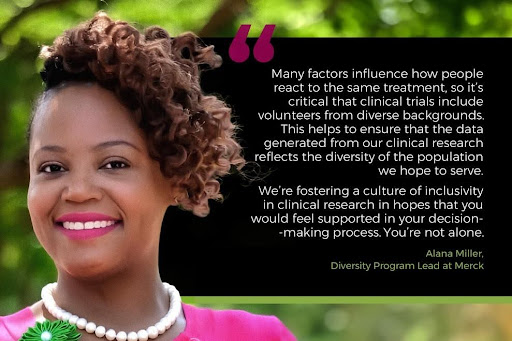
Sponsored by Merck
Clinical trials are research studies that are designed to learn more about how our bodies respond to investigational medicines. Any medicine, vaccine, medical device or procedure that is approved for public use has first been studied in a clinical trial. It is important to include participants from various backgrounds so we can help ensure the data we receive from the clinical trial reflects the diversity of the population we hope to serve. However, misunderstandings about clinical trials still prevent many people from taking steps to learn about and participate in clinical research.
In this article, we discuss common myths surrounding clinical trials and explore the impact of increased participation within underserved communities.
Myth #1: Participating in a clinical trial means being treated like a “guinea pig.”
In many communities of color, there is distrust for the medical community and clinical research because people’s race and socioeconomic status have been used against them.
However, it is important to know that clinical trials follow strict ethical guidelines and regulatory standards designed to help protect participants’ rights and safety. Before enrolling in a trial, participants receive detailed information about the study’s purpose, procedures, potential risks, and benefits, and have the opportunity to ask questions. This process, known as informed consent, allows patients to make voluntary and well-informed decisions about participation. Patients who enroll in clinical trials may choose to leave the trial at any time, for any reason.
Myth #2: Only people who have exhausted all treatment options should consider clinical trials.
Joining a trial doesn’t necessarily depend on whether you’ve explored other treatment options. Clinical trials aim to gather medical information by including participants at different stages of their illness. These participants may have diverse treatment backgrounds, including those who are newly diagnosed, have not responded to standard treatments or are exploring alternative options. Some clinical trials study an investigational medicine in combination with or in addition to a patient’s current treatment.
Myth #3: Clinical trials can be extremely expensive for patients.
Before enrolling in a clinical trial, participants receive detailed information about potential costs. Clinical trial sponsors and health insurance cover some of the costs associated with study-related procedures, treatments, and medical care. However, participants may be asked to pay for treatments and procedures not covered by insurance or sponsors. Some trials may offer reimbursement for participants’ study related expenses.
Myth #4: One person’s participation wouldn’t make a difference.
Increasing diverse representation in clinical trials is necessary and your participation could make a difference as it relates to healthcare disparities. Historically, clinical trial participants have often been white males, but the inclusion of diverse populations in clinical trials is important to understanding diseases and conditions, preventive factors, and treatment effectiveness across populations.¹

Ask your doctor if you may be eligible for a clinical trial. For more information, visit https://www.merckclinicaltrials.com/diversity-inclusion/.
+++



















